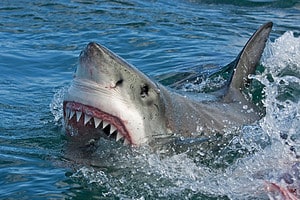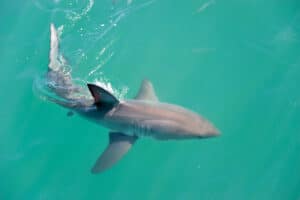Washington is the 18th-largest and northwesternmost state in the U.S. The western part of the state opens to the Pacific Ocean, a diverse area in terms of flora and fauna. But what about predators?
There are 500 different species of sharks roaming the planet’s oceans. Out of these, 30 species can be found in Washington State waters. The species present there are quite varied, especially in size.
This article will introduce you to some incredible sharks in Washington State waters. Usual caution is advised, as two shark attacks have been recorded in the area although both were non-fatal.
Are There Any Sharks in Washington State?
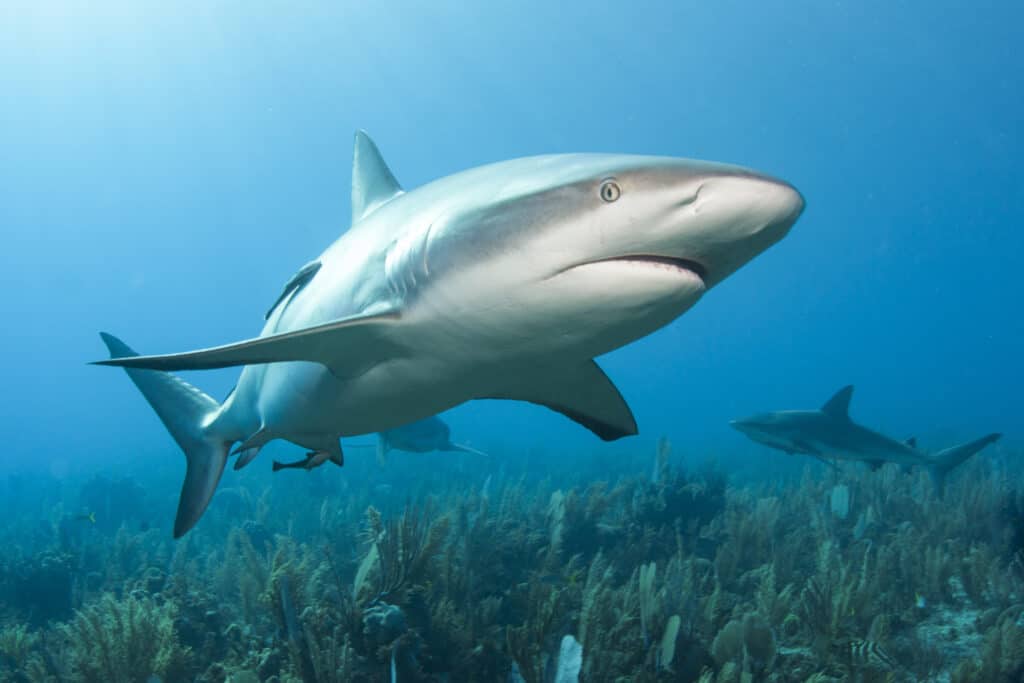
Washington has 30 species of sharks inhabiting its waters.
©Konstantin Novikov/Shutterstock.com
According to the Shark Foundation, Washington State waters are home to 30 shark species. Most species do not represent a danger to humans and swimmers, although caution is advised when exploring the ocean.
Sharks here are classified as primary predators, small, middle-class, gentle giants, and strangely shaped sharks. In the following lines, we introduce you to 14 sharks in Washington State waters!
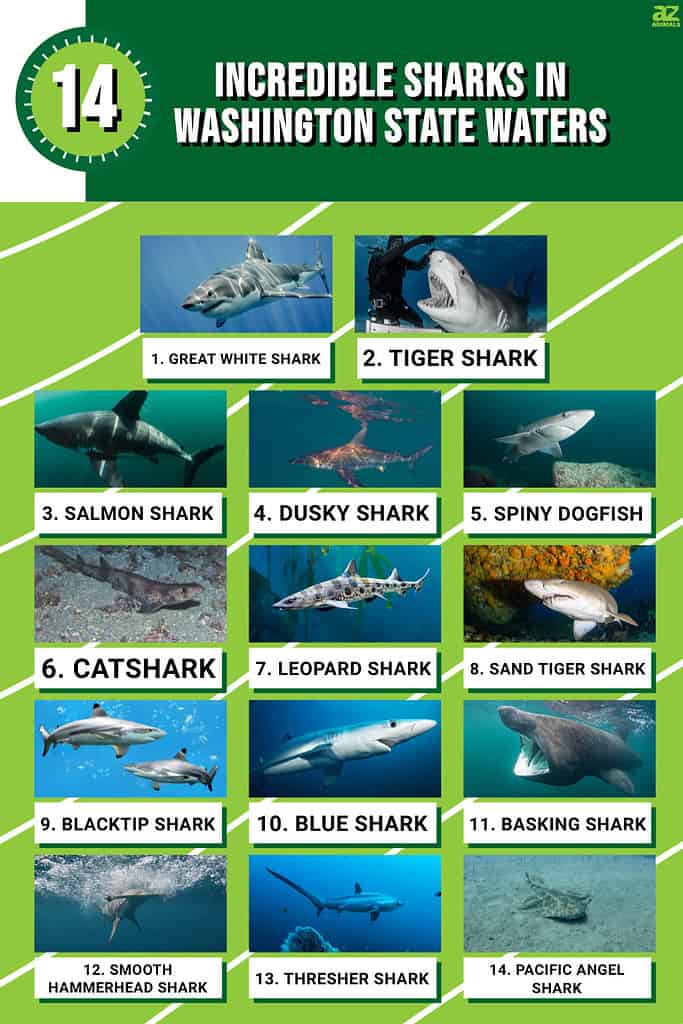
1. Great White Shark
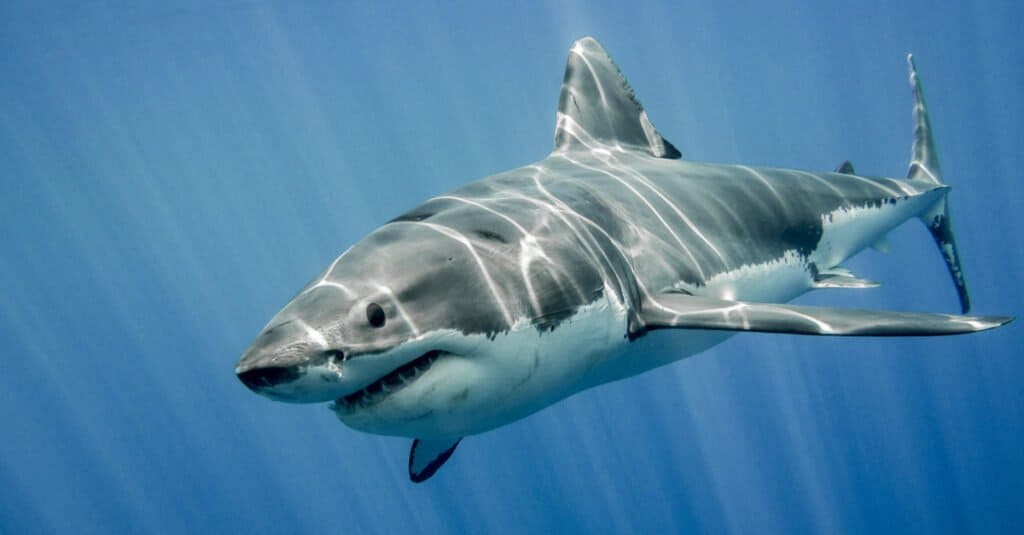
The great white shark is the only known surviving species of the
Carcharodongenus.
©Ramon Carretero/Shutterstock.com
| Size | Tooth length | Nature | Incredible Feature |
|---|---|---|---|
| 20 feet (6.1 m) | 2.4 inches (6 cm) | Highly aggressive | Largest-known extant macro predatory fish worldwide |
The great white shark is a species of mackerel shark. The species is one of the longest-living cartilaginous fishes, with a lifespan of over 70 years. It can be found in coastal surface waters worldwide.
A great white shark has an average swimming speed of 16 mph (25 kmh). As an apex predator, it has no natural predators. Only orcas are sometimes brave enough to hunt down great whites.
The great white shark is the only known surviving species of the Carcharodon genus. It is responsible for most human bite incidents amongst sharks worldwide.
2. Tiger Shark
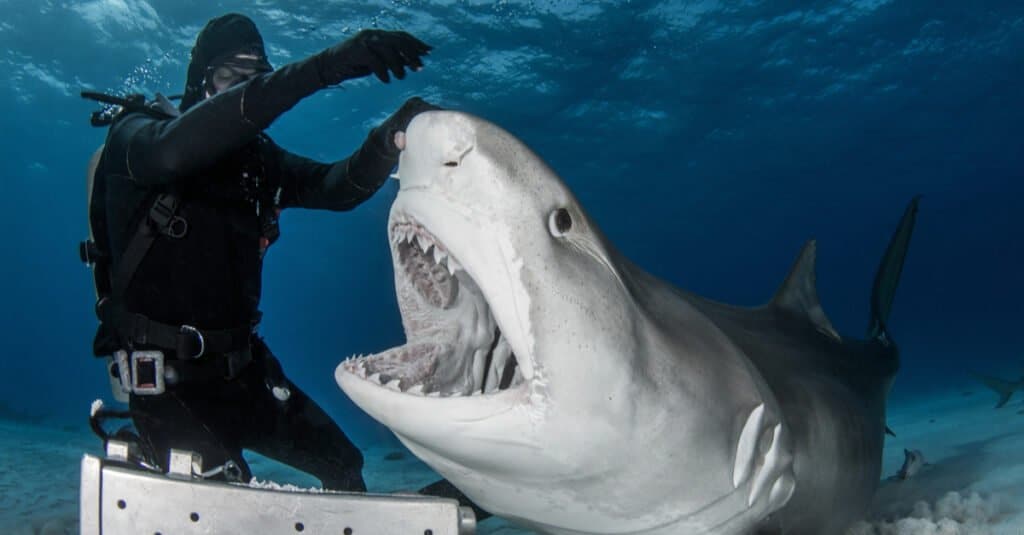
The
tiger
shark has the most recorded fatal attacks on humans worldwide after the great white shark.
©Tomas Kotouc/Shutterstock.com
| Size | Tooth length | Nature | Incredible Feature |
|---|---|---|---|
| 16.4 feet (5 m) | 1 inch (2.54 cm) | Curious and aggressive | Widest food spectrum of all sharks |
The tiger shark is a requiem shark: migratory, live-bearing, and living in warm seas. It was named “tiger” due to the dark stripes found on its lower body resembling a tiger’s pattern. The pattern fades, however, as the shark matures.
Even though the tiger shark is another apex predator, killer whale groups are known to hunt this species from time to time.
The tiger shark has the most recorded fatal attacks on humans worldwide after the great white shark. Despite that, it is still a near-threatened species, mainly due to fishing and finning.
3. Salmon Shark
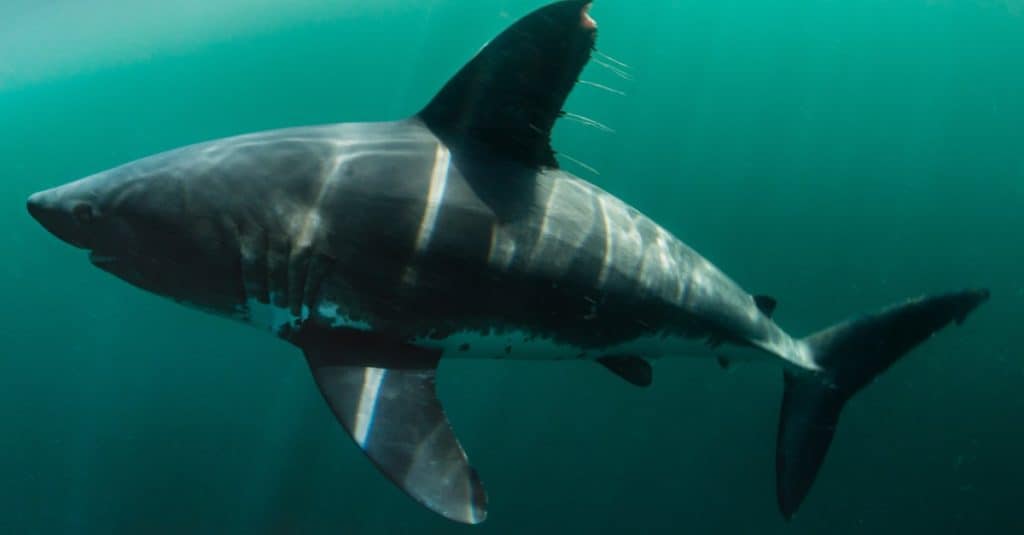
Salmon sharks are not currently being fished commercially.
©Warren Metcalf/Shutterstock.com
| Size | Tooth length | Nature | Incredible Feature |
|---|---|---|---|
| 6.6-8.6 feet (2-2.6 m) | Not measured | Aggressive | Ability to maintain stomach temperature (homeothermy) |
The salmon shark can be found predominantly in the northern part of the Pacific Ocean — right around Washington State. The species is known for its ability to regulate its body temperature. As a result, salmon sharks can live and thrive in cold waters.
As the name implies, the species feeds mainly on salmon, herring, sablefish, and squid.
Salmon sharks are not currently being fished commercially. In fact, it is known that fishers often discard them. In Miyagi, a city in Japan, however, salmon shark heart is considered a delicacy and is used to prepare sashimi.
4. Dusky Shark
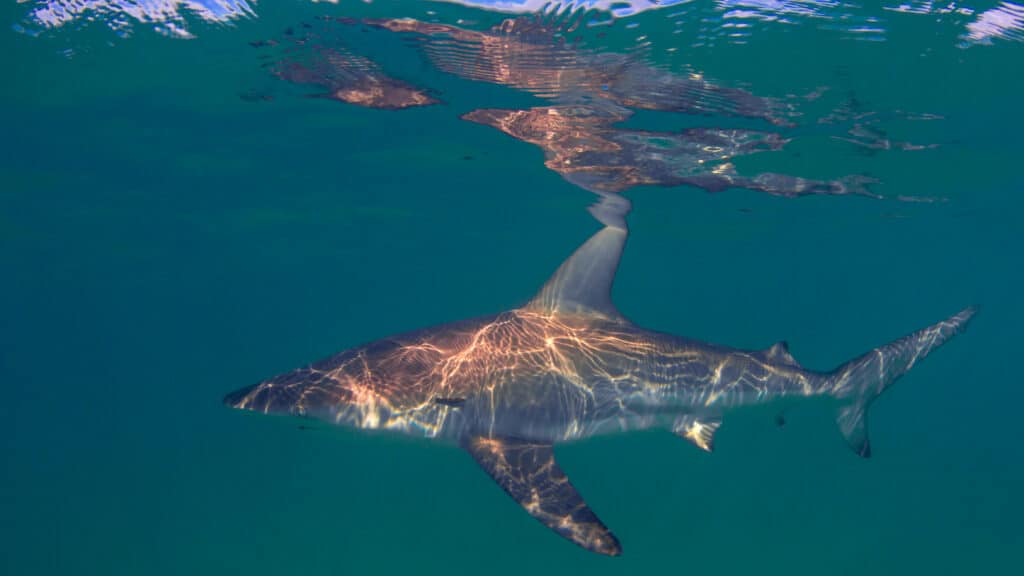
The dusky shark is one of the largest members of the
Carcharhinusgenus.
©Rich Carey/Shutterstock.com
| Size | Tooth length | Nature | Incredible Feature |
|---|---|---|---|
| 14 feet (4.2 m) | 1 inch (2.54 cm) | Not typically aggressive | Can eat up to a tenth of their weight in a single sitting |
The dusky shark is one of the largest members of the Carcharhinus genus. It has a varied diet, eating everything from sea turtles to sea stars, bony fish, rays, sharks, and even garbage. Dusky sharks are known for their slow-growing and maturing process. Such a shark reaches adulthood after 20 years!
One distinctive feature of dusky sharks is their short-rounded snout. The species is now considered endangered as commercial fisheries use it to make shark fin soup (a delicacy) and harvest it for skin, meat, and precious liver oil.
5. Spiny Dogfish
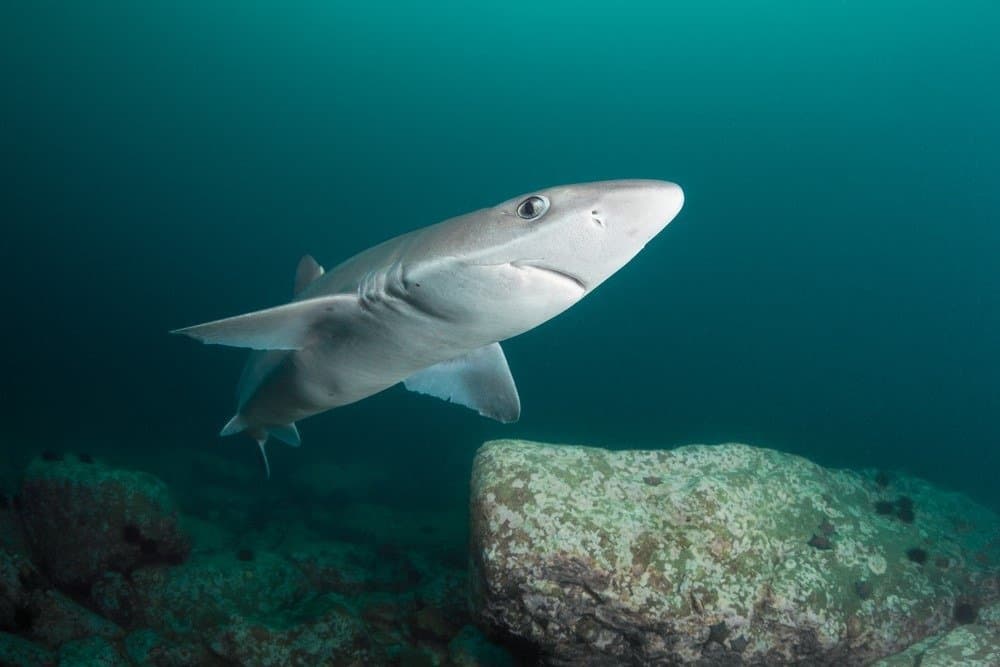
Spiny dogfish can be easily recognized by their two spines and the lack of an anal fin.
©Boris Pamikov/Shutterstock.com
| Size | Tooth length | Nature | Incredible Feature |
|---|---|---|---|
| 1.9 – 2.7 feet (60-80 cm) | Generally small | Aggressive | Dorsal fins secrete a mild venom |
Also known as spurdog or mud shark, this is the best-known species of the dogfish family. Spiny dogfish sharks can be easily recognized by their two spines and the lack of an anal fin. An interesting fact is that specimens found in the northern part of the Pacific were reevaluated and now constitute a separate species — the Pacific spiny dogfish.
Even though small, spiny dogfish sharks can be incredible predators. This is because this species often hunt in packs. This aspect wouldn’t be an issue to other marine animals and people — if these packs didn’t consist of hundreds, even thousands of specimens.
6. Catshark
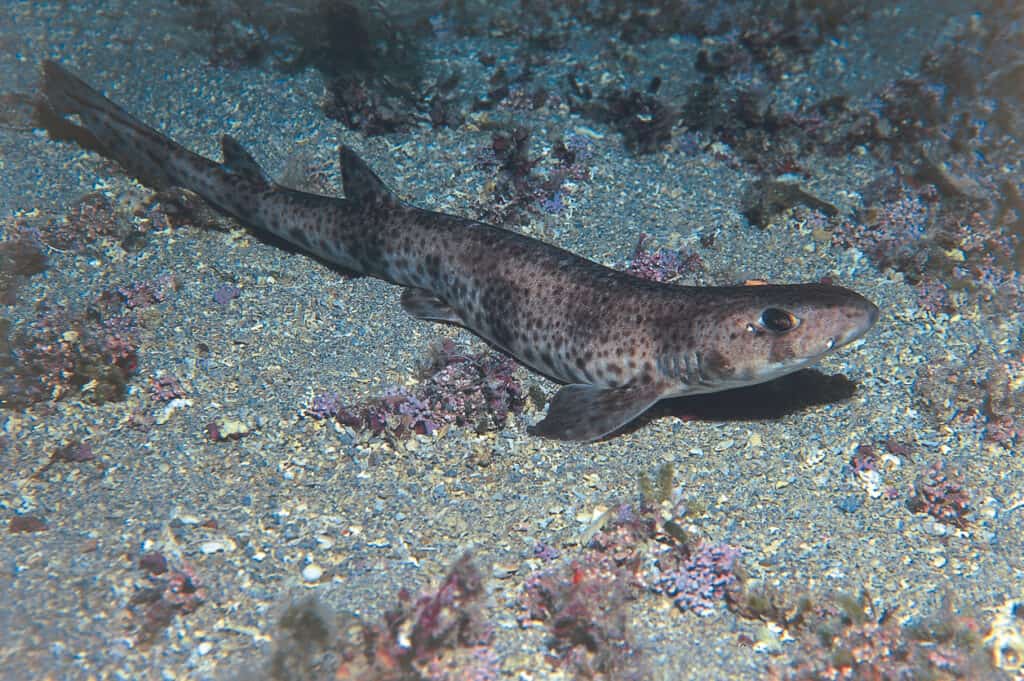
Catsharks reproduce by laying eggs.
©iStock.com/atese
| Size | Tooth length | Nature | Incredible Feature |
|---|---|---|---|
| Most species around 31 inches (80 cm) | Generally small | Not aggressive | Patterned appearance |
Catsharks are bottom dwellers; they reproduce by laying eggs. This must be mentioned as the species was previously named dogfish, but actual dogfish have live young offspring. The species is not harmful to humans, mainly because it dwells on the bottom of the ocean.
Various catshark species can be found on the bottom of Washington State waters. Divers might encounter them if they venture that deep. If they do, they might encounter the chain catshark, a species of this family that is biofluorescent.
7. Leopard Shark
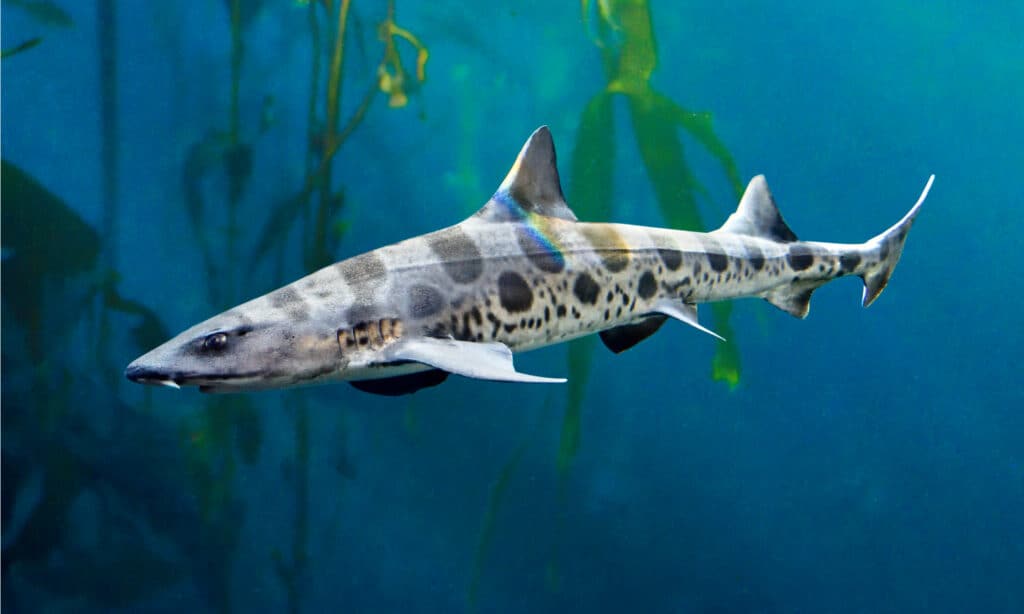
A
leopard
shark’s diet consists of shrimp, bony fish, clams, crabs, and fish eggs.
©Barbara Ash/Shutterstock.com
| Size | Tooth length | Nature | Incredible Feature |
|---|---|---|---|
| 3.9 – 4.9 feet (1.2-1.5m) | Short, flat teeth | Not aggressive | Black saddle-like markings pattern |
The leopard shark is known for its black saddle-like pattern and large spots that can be seen on its back. They are the reason behind its common name. The species’ diet consists of shrimp, bony fish, clams, crabs, and fish eggs.
This shark poses no danger to humans. The only attack ever recorded on humans resulted in a nosebleed on the diver’s part. You might not get to interact with one, as leopard sharks flee quickly.
8. Sand Tiger Shark
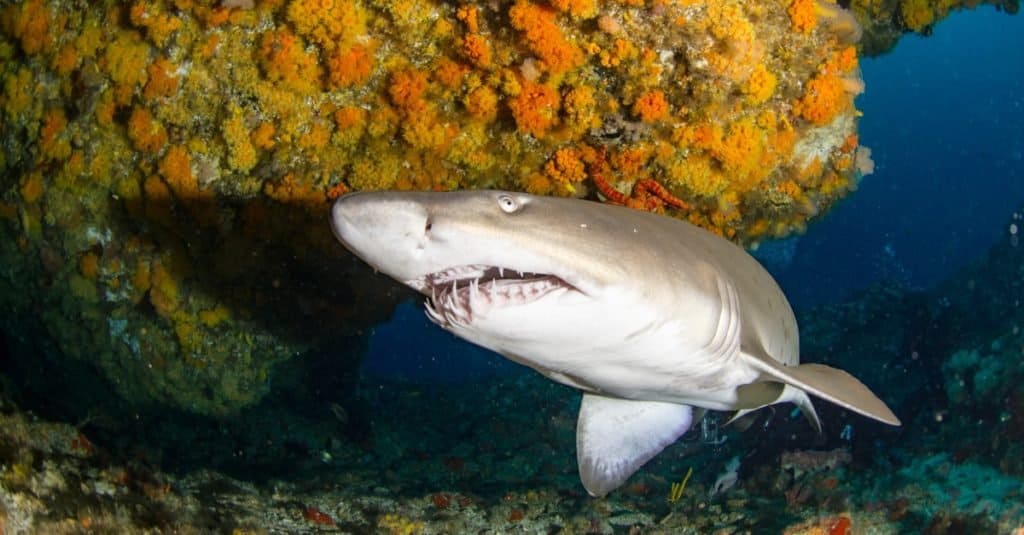
Sand tiger sharks can be found in Japan, South
Africa
, Australia, and North and South America.
©Stefan Pircher/Shutterstock.com
| Size | Tooth length | Nature | Incredible Feature |
|---|---|---|---|
| 10.5 feet (3.2 m) | 1 inch (2.54 cm) | Not aggressive | Can gulp air from the surface, suspending itself in the water column |
The sand tiger shark lives on sandy shorelines, often in submerged reefs as deep as 627 feet (191 m). The species can be found worldwide in Japan, South Africa, Australia, and North and South America. It is not related to the tiger shark.
There are no confirmed human fatalities related to the sand tiger shark. This is because the species moves slowly and is known as relatively placid.
9. Blacktip Shark
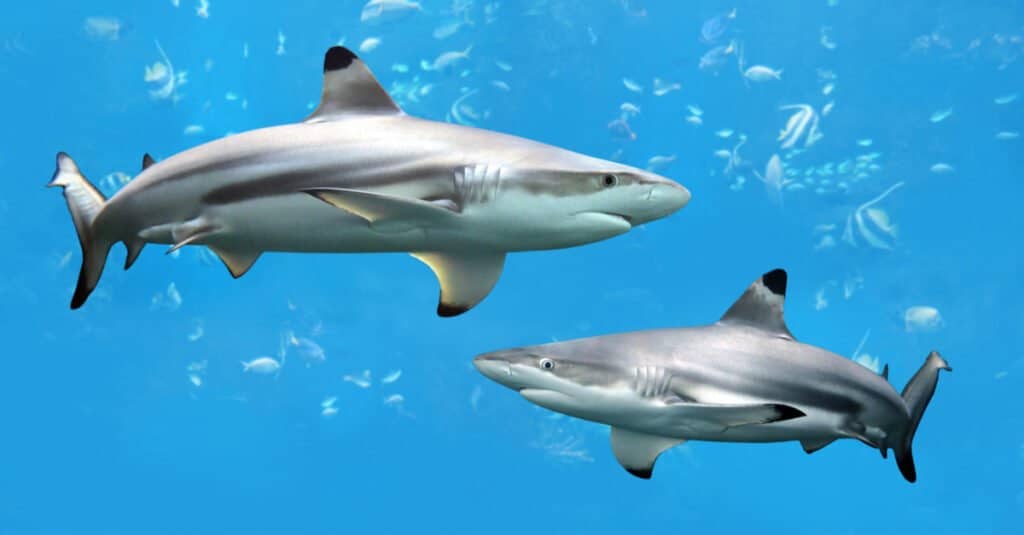
Blacktip sharks can move as fast as 21 feet per second.
©Gino Santa Maria/Shutterstock.com
| Size | Tooth length | Nature | Incredible Feature |
|---|---|---|---|
| 4.9 feet (1.5 m) | Not measured | Slightly aggressive | Engage in spinning leaps out of the water when hunting |
The blacktip shark is known for its pointed snout, fusiform body, and long gill slits. The edges of its caudal, dorsal, pectoral, or pelvic fins can feature black tips, hence the name of the species.
Blacktip sharks are known for engaging in spinning leaps out of the water, used to hunt schools of small fish or to dislodge sharksuckers. These sharks are extremely fast; before jumping out of the water, they can move as fast as 21 feet per second (6.3 m/s).
10. Blue Shark
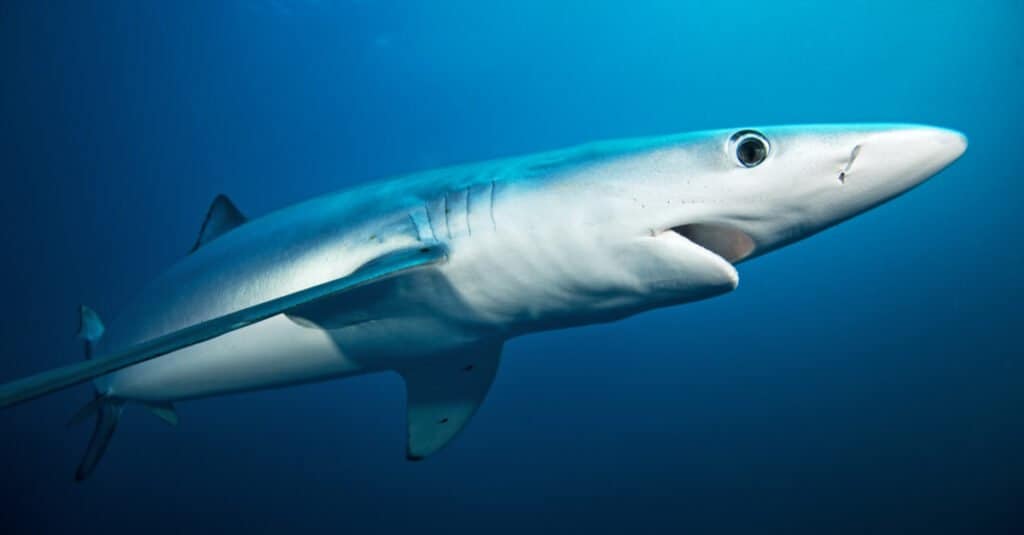
Blue sharks are also known as great blue sharks.
©Martin Prochazkacz/Shutterstock.com
| Size | Tooth length | Nature | Incredible Feature |
|---|---|---|---|
| 10 feet (3.1 m) | Sharp, medium-sized | Not aggressive | Unique sense of smell |
Also known as great blue sharks, the species lives in deep waters and prefers cooler waters. Even though the species can hunt larger prey, their diet consists mainly of squid and small fish.
They are known to migrate long distances. Specimens found in New England can also be found in South America.
Blue sharks are known for their large litter. Females can give birth to as few as 25 or more than 100 pups.
11. Basking Shark
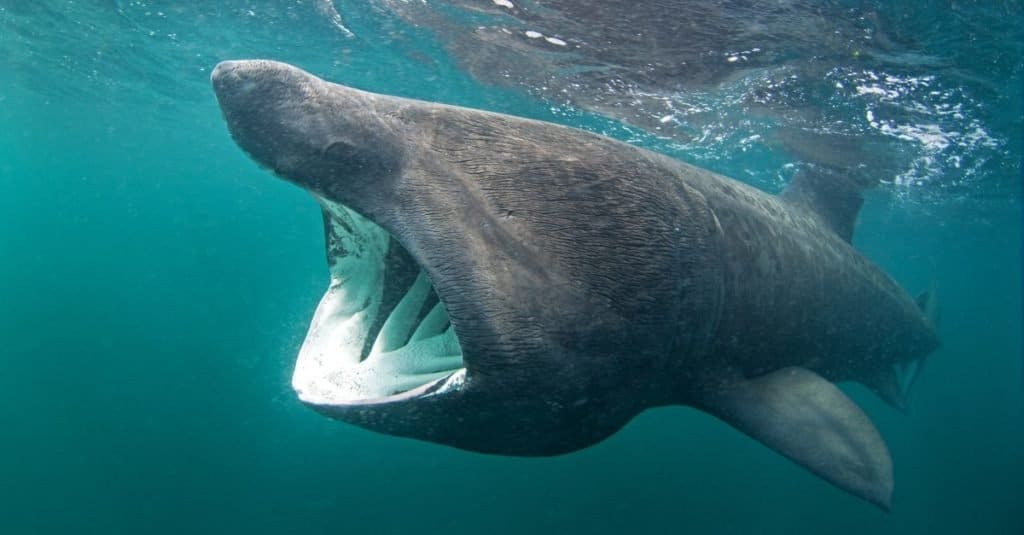
The basking shark is the second-largest living fish and shark worldwide.
©Martin Prochazkacz/Shutterstock.com
| Size | Tooth length | Nature | Incredible Feature |
|---|---|---|---|
| 26 feet (7.9 m) | 0.25 inches (0.6 cm) | Not aggressive | Second-largest living fish |
The basking shark is the second-largest living fish and shark worldwide (it stands behind the whale shark). Despite its size, the species is a filter feeder, meaning that it feeds on plankton by filtering water rather than hunting down large species of marine life.
It was named like this due to the fact that it feeds at the surface, seemingly basking in warm water. As a filter feeder, the basking shark doesn’t have much use for its teeth. Its mouth is equipped with several rows of teeth and one row can have up to 100 teeth. However, it is very small at 0.25 inches (0.6 cm) long.
12. Smooth Hammerhead Shark
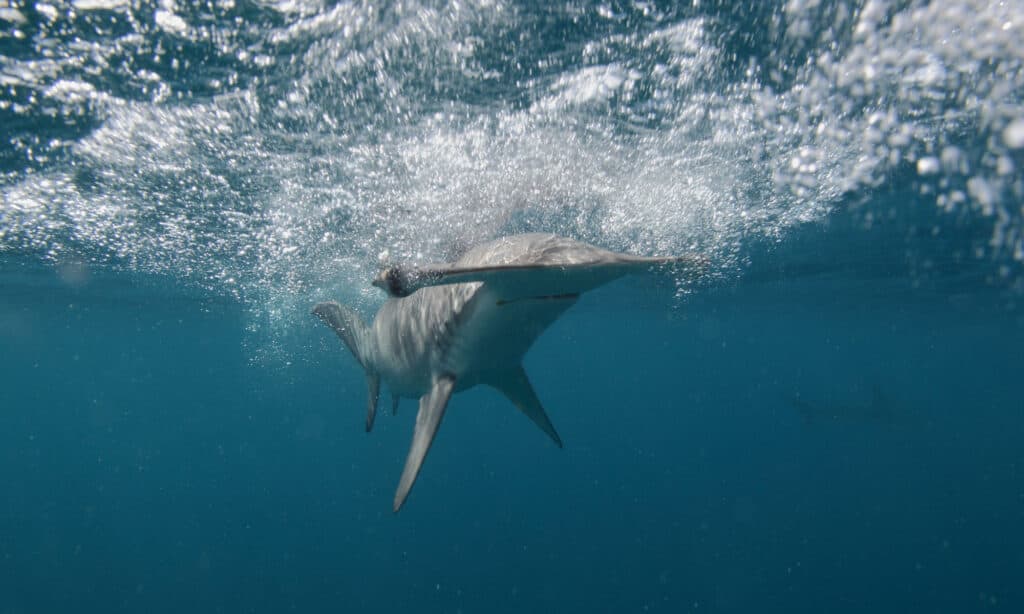
The smooth hammerhead shark is known for forming schools that range up to thousands of specimens.
©Alessandro De Maddalena/Shutterstock.com
| Size | Tooth length | Nature | Incredible Feature |
|---|---|---|---|
| 16 feet (5 m) | Sharp, average size | Potentially dangerous | Can form schools numbering thousands of individuals |
The smooth hammerhead shark is the second-largest of the hammerhead species. It is called smooth because its head is flattened and extended into a hammer shape. The shark is known for forming schools that range up to thousands of specimens.
Its diet consists mainly of invertebrates and bony fishes. Larger specimens, however, often hunt rays and other sharks as well.
13. Thresher Shark
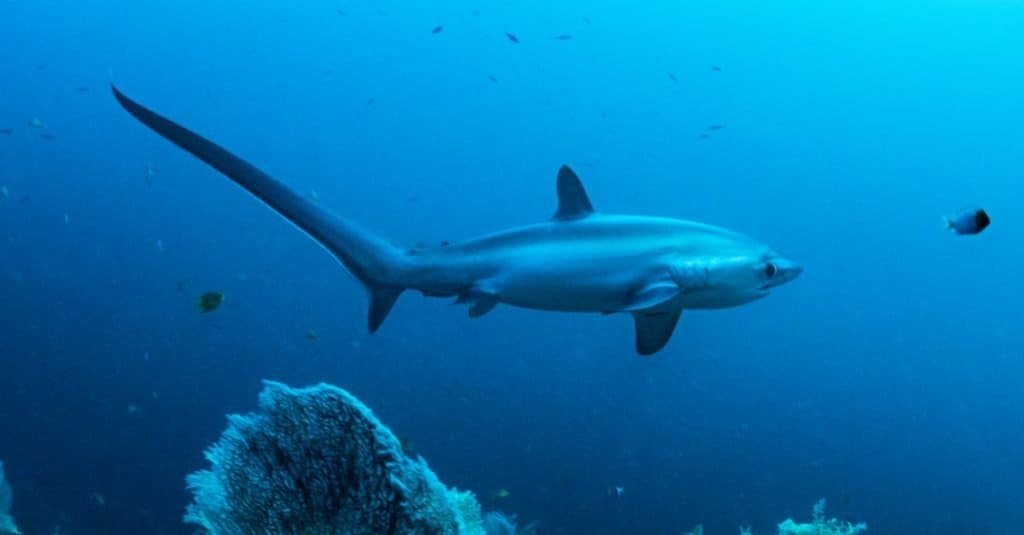
Thresher sharks are commonly hunted for meat, skin, fins, and liver.
©Shane Gross/Shutterstock.com
| Size | Tooth length | Nature | Incredible Feature |
|---|---|---|---|
| Common thresher 20 feet (6.1 m), bigeye thresher 16 feet (4.9 m), pelagic thresher 10 feet (3 m) | 2 inches (4 cm) in the case of large specimens | Common thresher is aggressive | Exceptionally long tail that is often used to stun prey |
Thresher refers to species of mackerel sharks that are listed as vulnerable to extinction. All three extant species of thresher shark are known as sport fish and are commonly hunted for meat, skin, fins, and liver.
The name thresher is given by the species’ distinctive caudal fin that resembles a tail and can be as long as the thresher shark specimen.
14. Pacific Angel Shark
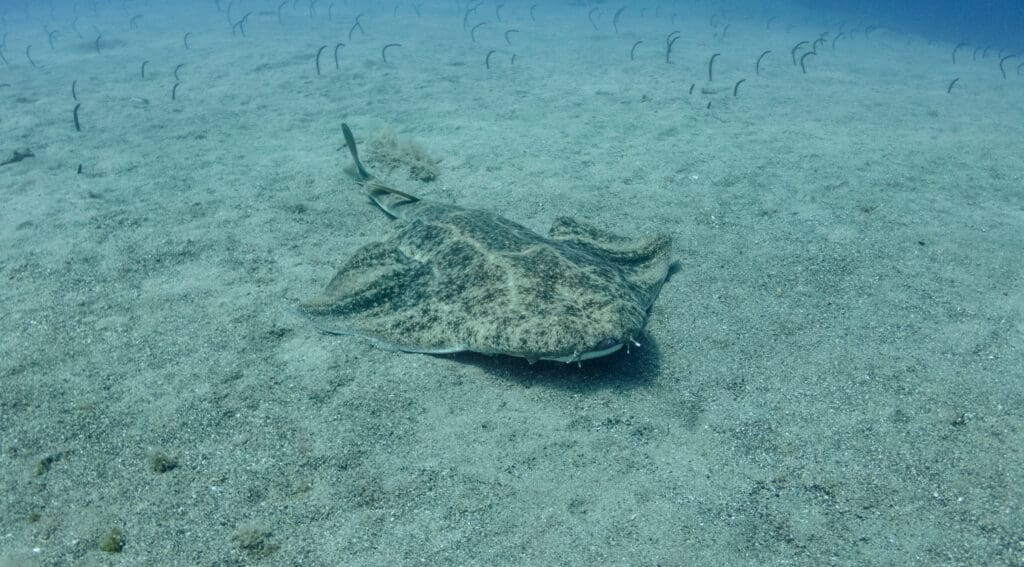
The Pacific angel shark has a flattened body and enlarged pelvic and pectoral fins.
©LuisMiguelEstevez/Shutterstock.com
| Size | Tooth length | Nature | Incredible Feature |
|---|---|---|---|
| 4.9 feet (1.5 m) | Short, sharp teeth | Not aggressive unless provoked | Can remain concealed for up to 10 days, waiting for prey |
The Pacific angel shark has a flattened body and enlarged pelvic and pectoral fins. It is known as an ambush predator. Pacific angel sharks conceal on the seafloor, using sand and their natural camouflage, and wait for prey. This species can stay still for days, concealed in their ambush site. Its diet consists mainly of squid and bony fish.
Summary of 14 Incredible Sharks in Washington State Waters
Here’s a recap of 14 types of sharks found in the state of Washington that we took a close look at:
| Rank | Shark | Incredible Feature |
|---|---|---|
| 1 | Great White Shark | Largest-known extant macro predatory fish worldwide |
| 2 | Tiger Shark | Widest food spectrum of all sharks |
| 3 | Salmon Shark | Ability to maintain stomach temperature |
| 4 | Dusky Shark | Can eat up to a tenth of their weight in a single sitting |
| 5 | Spiny Dogfish | Dorsal fins secrete a mild venom |
| 6 | Catshark | Patterned appearance |
| 7 | Leopard Shark | Black saddle-like markings pattern |
| 8 | Sand Tiger Shark | Gulps air from surface, suspending itself in a water column |
| 9 | Blacktip Shark | Engages in spinning leaps out of the water when hunting |
| 10 | Blue Shark | Unique sense of smell |
| 11 | Basking Shark | Second-largest living fish |
| 12 | Smooth Hammerhead Shark | Can form schools numbering thousands of individuals |
| 13 | Thresher Shark | Exceptionally long tail often used to stun prey |
| 14 | Pacific Angel Shark | Can remain concealed for up to 10 days waiting for prey |
The photo featured at the top of this post is © Stefan Pircher/Shutterstock.com
Thank you for reading! Have some feedback for us? Contact the AZ Animals editorial team.



